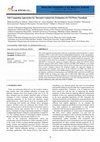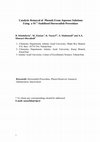Papers by Ramin Khodafarin

Journal of Enzyme Inhibition and Medicinal Chemistry, 2005
In the presence of the anionic surfactant sodium n-dodecyl sulphate (SDS), horseradish peroxidase... more In the presence of the anionic surfactant sodium n-dodecyl sulphate (SDS), horseradish peroxidase (HRP) undergoes a deactivation process. Suicide inactivation of horseradish peroxidase by hydrogen peroxide(3 mM) was monitored by the absorbance change in product formation in the catalytic reaction cycle. The progress curve of the catalytic reaction cycle was obtained at 278C and phosphate buffer 2.5 mM ðpH ¼ 7:0Þ: The corresponding kinetic parameters i.e., intact enzyme activity (a i); the apparent rate constant of suicide inactivation by peroxide (k i); and the apparent rate constants of enzyme deactivation by surfactant (k d) were evaluated from the obtained kinetic equations. The experimental data are accounted for by the equations used in this investigation. Addition of SDS to the reaction mixture intensified the inactivation process. The deactivation ability of denaturant could be resolved from the observed inactivation effect of the suicide substrate by applying the proposed model. The results indicate that the deactivation and the inactivation processes are independent of each other.

International Journal of Heat and Mass Transfer, 2012
One of the auspicious nanomaterials which has exceptionally enticed researchers is carbon nanotub... more One of the auspicious nanomaterials which has exceptionally enticed researchers is carbon nanotubes (CNTs) as the result of their excellent thermal properties. In this investigation, an experiment was carried out on three kinds of CNTs-nanofluids with various CNTs added to de-ionized water to compared and analyze their thermal conductivity properties. The main purpose of this study was to introduce a combination of experimental and modelling approaches to forecast the amount of thermal conductivity using four different neural networks. Between MLP-ANN, ANFIS, LSSVM, and RBF-ANN Methods, it was found that the LSSVM produced better results with the lowest deviation factor and reflected the most accurate responses between the proposed models. the regression diagram of experimental and estimated values shows an R2 coefficient of 0.9806 and 0.9579 for training and testing sections of the ANFIS method in part a, and in the b, c and d parts of the diagram, coefficients of determination were 0.9893& 0.9967 and 0.9974 & 0.9992 and 0.9996& 0.9989 for training and testing part of MLP-ANN, RBF-ANN and LSSVM models. Also, the effect of different parameters was investigated using a sensitivity analysis method which demonstrates that the temperature is the most affecting parameter on the thermal conductivity with a relevancy factor of 0.66866.
Colloids and Surfaces B: Biointerfaces, 2006
Kinetics of urease denaturation by anionic surfactant (sodium n-dodecyl sulphate, SDS) at concent... more Kinetics of urease denaturation by anionic surfactant (sodium n-dodecyl sulphate, SDS) at concentrations below the critical micelle concentration (CMC) is investigated spectrophotometrically at neutral pH and the corresponding two-phase kinetic parameters of the process are estimated from a three-state reversible process using a binomial exponential relation based on the relaxation time method as: Native (N) k 1 k −1 Intermediate (I) k 1 k −2 Denatured (D) Using a prepared computer program, the experimental data are properly fitted into a binomial exponential relation, considering a two-phase denaturation pathway including a kinetically stable folded intermediate formed at SDS concentration of 1.1 mM. Forward and backward rate constants are estimated as:
Chattam House Briefing Papers, August, 2005

Iran has the second largest natural gas reserves in the world. Therefore, it is heavily investing... more Iran has the second largest natural gas reserves in the world. Therefore, it is heavily investing in expanding its gas production, processing, and transportation capacity. The main objectives include: Promoting the usage of natural gas as a low carbon fuel and primary source of energy to reduce the domestic demand on oil. Using natural gas for EOR and pressure maintenance in mature oil fields. Exporting natural gas and its products. However, expanding the natural gas network demands a more comprehensive research on potential gas hydrate problems and mitigation techniques. In this communication, we give a review on typical gas hydrate problems in the Iranian production and gas transportation facilities and networks and various prevention techniques. We also present details of construction and commissioning of a hydrate test rig at the Research Institute of Petroleum Industry (RIPI) of the National Iranian Oil Company (NIOC). Finally, we present experimental data on the hydrate stability zone of some Iranian natural gases. We conclude that further national and international research and investment is beneficial to minimize gas hydrate risks in the Iranian Gas Industries, as well as exploring positive applications of gas hydrates with respect to specific conditions in Iran.
Biomass Conversion and Biorefinery
Journal of the Iranian Chemical Society, 2005
The present research discusses the structure stabilizing and protecting effects of Ni 2+ against ... more The present research discusses the structure stabilizing and protecting effects of Ni 2+ against suicide-peroxide inactivation of horseradish peroxidase (HRP). Suicide inactivation of HRP by hydrogen peroxide (3 mM) was monitored by measuring change in the absorbance of the colored product (tetraguaiacol) of the catalytic reaction cycle at 470 nm. Progress curves of the catalytic reaction cycle were obtained at 27 o C, phosphate buffer (5 mM), pH 7.0. The corresponding kinetic parameters (e.g., initial enzyme activity (α o) and the apparent rate constant (k i) of suicide inactivation of HRP by peroxide) were evaluated using a kinetic equation derived in this study. Comparative activatory and inhibitory effects of Ni 2+ on the kinetics of suicide-peroxide inactivation of HRP are discussed.
Experimental Thermal and Fluid Science, 2011
Preparing a stable nanofluid with high thermal conductivity is of a great concern. In order to fi... more Preparing a stable nanofluid with high thermal conductivity is of a great concern. In order to find an optimum dispersion method to achieve a better performance, five different carbon nanotube (CNT) structures, namely SWNTs (single wall CNT), DWNTs (double wall CNT), FWNTs (few wall CNT) and two different MWNTs (multiwall nanotubes) were synthesized to prepare nanofluids with three different dispersion methods namely functionalization, SDS/ultrasonic probe and SDS/ultrasonic bath. The experiments reveal that the best stability and thermal conductivity are associated with the functionalized nanofluids. Specifically, for the times after 50 h, the functionalized profiles begin to level off due to their higher stability, while the other two paths continue their declining trend.
pet.hw.ac.uk
Batch production of natural gas hydrate (NGH) is carried out by enhancing the formation process u... more Batch production of natural gas hydrate (NGH) is carried out by enhancing the formation process using specific materials at about 100 bar and 4 oC. On the onset of hydrate formation suitable low dosage hydrate stabilizer was injected into the pressure ...
Batch production of natural gas hydrate (NGH) is carried out by enhancing the formation process u... more Batch production of natural gas hydrate (NGH) is carried out by enhancing the formation process using specific materials at about 100 bar and 4 o C. On the onset of hydrate formation suitable low dosage hydrate stabilizer was injected into the pressure reactor to stabilize the produced hydrate for the subsequent storage and transportation. In order to obtain a gas-rich dry-hydrate a heating-cooling regime was applied inside the hydrate metastable zone leading to melting the present ice, filling the hydrate cages and converting the remaining liquid water to hydrate. The used additives are able to produce gas-rich NGH (increasing storage capacity), enhancing hydrate formation rate, and stabilizing the hydrate structure for lower pressure storage and transportation.

Iran has the second largest natural gas reserves in the world. Therefore, it is heavily investing... more Iran has the second largest natural gas reserves in the world. Therefore, it is heavily investing in expanding its gas production, processing, and transportation capacity. The main objectives include: Promoting the usage of natural gas as a low carbon fuel and primary source of energy to reduce the domestic demand on oil. Using natural gas for EOR and pressure maintenance in mature oil fields. Exporting natural gas and its products. However, expanding the natural gas network demands a more comprehensive research on potential gas hydrate problems and mitigation techniques. In this communication, we give a review on typical gas hydrate problems in the Iranian production and gas transportation facilities and networks and various prevention techniques. We also present details of construction and commissioning of a hydrate test rig at the Research Institute of Petroleum Industry (RIPI) of the National Iranian Oil Company (NIOC). Finally, we present experimental data on the hydrate stability zone of some Iranian natural gases. We conclude that further national and international research and investment is beneficial to minimize gas hydrate risks in the Iranian Gas Industries, as well as exploring positive applications of gas hydrates with respect to specific conditions in Iran.

Crude horserasish peroxidase in a bench-scale was prepared from a fig extract and purified by ste... more Crude horserasish peroxidase in a bench-scale was prepared from a fig extract and purified by stepwise preparetive column chromatography(Sephadex G25 and DEAE-Cellulose columns) to obtain a sample solution with a purity index of RZ~2.3. Reaction conditions on removal of ortho-methoxy phenol (guaiacol, as a typical phenolic compound) by enzymatic polymerization/precipitation process in the presence of hydrogen peroxide were optimized using the Taguchi method. Variables including the amounts of guaiacol, hydrogen peroxide, enzyme concentration, temperature and pH of the solution were selected and used in a L 8 array. Main effects between interacting variables and also the optimum conditions of the process are well established and examined using the Qualitek-4 software. Limiting factors such as thermal stability, conformational stability and pH stability of HRP and also suicide-substrate inactivation of the enzyme ([H 2 O 2 ]>2 mM) are also attended in the model. Results showed that at lower concentrations of HRP (5 nM) the optimum pH value is 7.0 while the removal efficiency improved at lower temperatures. At higher concentrations of the enzyme(12 nM), ambient temperatures(~25 o C) and under condition of gradual addition of peroxide (so that concentration of H 2 O 2 in the reaction mixture kept below than 2 mM) the removal efficiency reached to a value of about 99%. The optimum conditions for such enzymatic removal of guaiacol and consequently the other harmful pollutant phenolic compounds (They may find in wastes of oil refining, resins, polymers, plastics and fibers processing and also in textile and dye industries) were obtained as: [HRP]=12 nM, Temperature 25 o C, [H 2 O 2 ]=1.0 mM, pH=7.0(phosphate buffer 5 mM) and [guaiacol]=100 ppm.

Reaction conditions on removal of ortho-methoxy phenol (guaiacol, as a typical phenolic compound)... more Reaction conditions on removal of ortho-methoxy phenol (guaiacol, as a typical phenolic compound) by enzymatic polymerization/precipitation process in the presence of hydrogen peroxide were optimized using the Taguchi method. Variables including the amounts of guaiacol, hydrogen peroxide, Horseradish peroxidase(HRP) concentration, temperature and pH of the solution were selected and used in a L 8 array. Main effects between interacting variables and also the optimum conditions of the process are well established and examined. Limiting factors such as thermal stability, conformational stability and pH stability of HRP and also suicide-substrate inactivation of the enzyme ([H 2 O 2 ]>2 mM) are also attended in the model. Results showed that at lower concentrations of HRP (5 nM) the optimum pH value is 7.0 while the removal efficiency improved at lower temperatures. At higher concentrations of the enzyme (12 nM), low temperatures (25 o C) and under condition of gradual addition of peroxide (so that concentration of H 2 O 2 in the reaction mixture kept below than 2 mM) the removal efficiency reached to a value of about 99%. The optimum conditions for such enzymatic removal of phenolic were evaluated as: [HRP]=12 nM, Temperature 5-15 o C, [H 2 O 2 ]=1.1 mM, pH=7.0 (phosphate buffer 5 mM) and [guaiacol]=100 ppm. These conditions may be applied to a pilot-scale process among with a further correction of optimized variables, which may provide an industrial approach for using of HRP in such removal processes. Suicide inactivation of HRP by hydrogen peroxide (3 mM) was monitored by increasing in the absorbance of the color product of the catalytic reaction cycle.

Horseradish peroxidase (HRP) catalyses the oxidation of aromatic hydrogen donors by hydrogen pero... more Horseradish peroxidase (HRP) catalyses the oxidation of aromatic hydrogen donors by hydrogen peroxide through a two-electron transferring pathway. Nowadays, industrial applications of peroxidase in chemistry and biotechnology are well developed. Peroxidase may use in waste treatment in order to remove aromatic phenols and amines from the aqueous solutions in the presence of hydrogen peroxide. Suicide–peroxide inactivation has been proved to reduce the sensitivity and efficiency of peroxidase. So the role of such suicide reactions must be considered and various techniques for reducing the role of suicide inactivation must be applied. Among such methods the use of PEG (with various molecular weights) have been reported to increase the lifetime of the enzyme. Present research discusses the structure stabilizing and protecting effects of Ni +2 against suicide–peroxide inactivation of HRP. Suicide inactivation of HRP by hydrogen peroxide (3 mM) was monitored by increasing in the absorbance of the colored product of the catalytic reaction cycle. Progress curves of the catalytic reaction cycle were obtained at 27 o C, phosphate buffer (2.5 mM), pH=7.0. The corresponding kinetic parameters (e.g., intact enzyme activity ,α i ; and the apparent rate constant of suicide inactivation of HRP by peroxide, k i) were evaluated from the obtained kinetic equation.
Thermal conductivity and stability of carbon nanotube (CNT) structures in water-based nanofluid, ... more Thermal conductivity and stability of carbon nanotube (CNT) structures in water-based nanofluid, as well as their dependence to temperature and time variation are of a great concern. In order to investigate such dependence, five different structures, namely SWNT (single wall CNT), DWNT (double wall CNT), FWNT (few wall CNT) and two different multiwalls were applied in this study. The experiments reveal that the maximum UV–VIS absorbance of the solution corresponds to the dispersion of SWNT in the base fluid. The results from zeta size distribution and thermal conductivity demonstrate that as the number of nano-tube wall increase, both stability and thermal conductivity decrease.











Uploads
Papers by Ramin Khodafarin